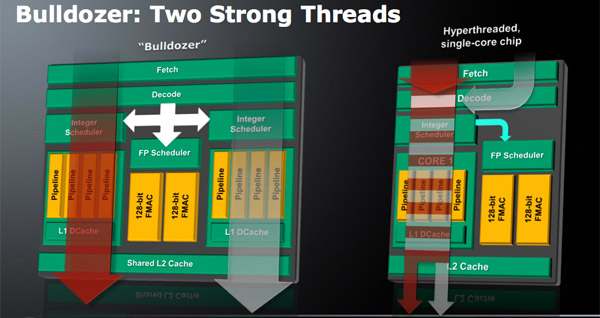AMD Discloses Bobcat & Bulldozer Architectures at Hot Chips 2010
by Anand Lal Shimpi on August 24, 2010 1:33 AM ESTBulldozer
AMD already gave us a good amount of detail on Bulldozer earlier this year. We’ll start with a quick refresher.
With Nehalem, Intel moved to a more modular design process that would allow it the ability to quickly configure different versions of the chip to hit various markets. With Bulldozer, AMD is doing the same.
The basic building block is the Bulldozer module. AMD calls this a dual-core module because it has two independent integer cores and a single shared floating point core that can service instructions from two independent threads. The two thread machine is larger than a single core but smaller than two cores with straight duplication of resources.

All else being the same, it should give you more threaded performance than a single SMT (Hyper Threaded) core but less than two dedicated cores. The savings are obviously on the die side. AMD tells us that the second integer core increases the Bulldozer module die by around 12%, despite significantly increasing performance in threaded integer applications.

Processors may implement anywhere from one to four Bulldozer modules and will be referred to as 2 to 8 core CPUs. Each core appears to the OS as a logical processor similar to what you get with Hyper Threading. A CPU with four Bulldozer modules would appear as an 8-threaded processor under Task Manager in Windows.
AMD argues that the Bulldozer module is ideal provisioning of hardware. With SMT (Hyper Threading) you force too much into a single core, while with traditional multicore you often waste hardware as any idle resources are duplicated across the chip.

Bulldozer CPUs will be AMD’s first 32nm processors manufactured at GlobalFoundries.
The new details today are about everything inside of the Bulldozer module.










76 Comments
View All Comments
ROad86 - Thursday, August 26, 2010 - link
I think without being a pc expert that amd was trying to maximaze the multi-thread perfomance in less die size and being more efficient at power consumption. But i believe that they are still developing Bulldozer in order to maximaze single thread perfomance too. In desktop not much applications are threaded well in enough so they have to be competive in single thread perfomance too. Thats why I believe they dont announce release date yet. Among side the new manufactaring procces at 32 nm and I think the waiting for the release of sandy-bridge in order to see how better are intel new processors, the release date will be probably Q4 2011. But these are just speculations.Vallwesture - Thursday, August 26, 2010 - link
It has been over two years...ROad86 - Thursday, August 26, 2010 - link
New architecture, completly new design, maybe softaware too needs too be optimazed(windows 7 for example), in the end lets hope to bring something truly amazing. On paper it does but lets wait for reviews!KonradK - Thursday, August 26, 2010 - link
"The basic building block is the Bulldozer module. AMD calls this a dual-core module because it has two independent integer cores and a single shared floating point core that can service instructions from two independent threads"I'm curious whether CPU shedulers can distinguish between cores located in the same module from cores located in other modules of Bulldozer .
Because two cores located in the same module share one FPU unit , running two FPU heavy threads on two cores located in the same module and leaving cores in other modules idle would be at least unoptimal.
Simen1 - Tuesday, August 31, 2010 - link
From page 6: "Aggressive prefetching usually means there’s a good amount of memory bandwidth available so I’m wondering if we’ll see Bulldozer adopt a 3 - 4 channel DDR3 memory controller in high end configurations similar to what we have today with Gulftown."AMD already have a 4 channel DDR3 design. Its in the Opteron 6100-line of processors on the G34 socket (LGA1974). AMD have promised it will be compatible with future bulldozer-based processors.
liem107 - Monday, September 6, 2010 - link
I wonder how bobcat would fare against the VIA Nano. Considering VIA s portfolio, it would be a good aquisition for Nvidia for example to get their hands on a fairly good x86 core and license.